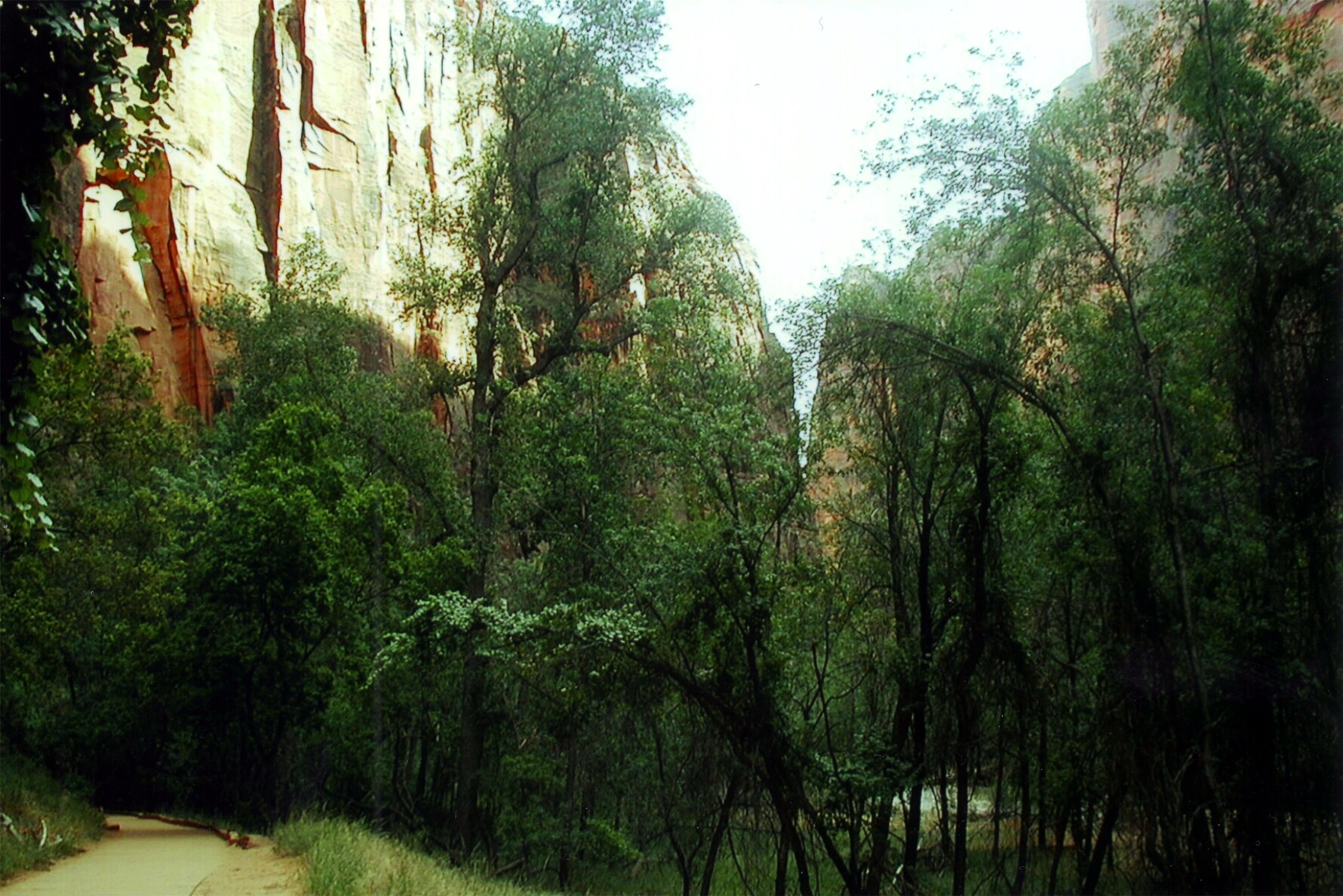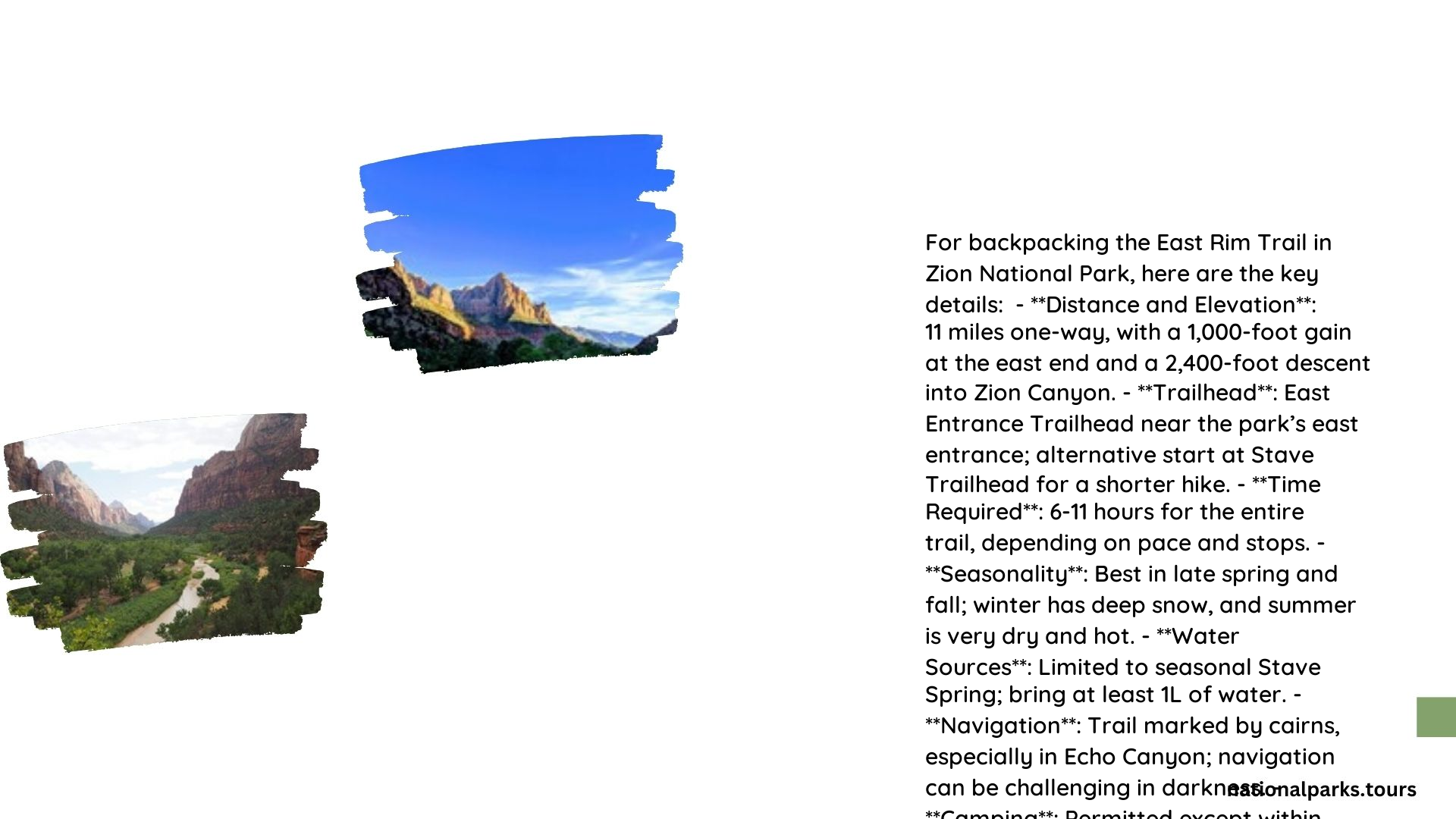The East Rim Trail in Zion National Park offers a challenging and rewarding backpacking experience. This 10.8-mile one-way trail features stunning canyon views, diverse landscapes, and a 2,300-foot elevation change. Backpackers must obtain wilderness permits for overnight stays and practice Leave No Trace principles in designated camping areas. The trail provides access to iconic viewpoints like Observation Point and passes through varied terrain, from pine forests to slickrock expanses.
What is the East Rim Trail Overview?

The East Rim Trail in Zion National Park is a strenuous backpacking route that showcases the park’s diverse landscapes and breathtaking vistas. Here are the key details:
- Trail Length: 10.8 miles one-way
- Elevation Change: 2,300 feet total (1,000 feet gain, 2,400 feet loss)
- Difficulty: Moderate to strenuous
- Terrain: Varied, including pine forests, slickrock, and canyon edges
- Highlights: Panoramic views of Zion Canyon, access to Observation Point
What are the Camping Regulations for East Rim Backpackers?

When planning your backpacking trip on the East Rim Trail, it’s crucial to understand and follow the camping regulations:
- Wilderness Permits: Required for all overnight stays
- Camping Areas: No established campsites; practice “open camping” in designated areas
- Leave No Trace: Adhere to principles to minimize environmental impact
- Water Sources: Limited; Stave Spring is the primary source but can be unreliable
- Fire Restrictions: Check current regulations; often prohibited due to fire risk
How to Obtain Wilderness Permits for East Rim Backpacking?
Securing a wilderness permit is essential for your East Rim backpacking adventure:
- Online Reservation: Available through the Zion National Park website
- In-Person: Obtain at the Zion Wilderness Desk
- Advance Booking: Recommended, especially during peak seasons
- Fees: Associated costs vary; check current rates on the park’s website
- Group Size Limits: Typically restricted to 12 people or fewer
What are the Key Points of Interest Along the East Rim Trail?
The East Rim Trail offers several notable attractions and viewpoints:
| Point of Interest | Description | Distance from Trailhead |
|---|---|---|
| Stave Spring | Primary water source (seasonal) | Approximately 3 miles |
| Cable Mountain | Panoramic views of Zion Canyon | About 6 miles |
| Deertrap Mountain | Secluded viewpoint | Roughly 7 miles |
| Observation Point | Iconic vista of Zion Canyon | 8 miles (via spur trail) |
| East Mesa Trail Junction | Access to alternative route | 7.5 miles |
What Should be Included in Your East Rim Backpacking Gear List?
Proper gear is crucial for a safe and enjoyable East Rim backpacking experience. Here’s a comprehensive list:
- Backpack (50-65 liters)
- Lightweight tent or bivy sack
- Sleeping bag rated for expected temperatures
- Sleeping pad
- Water filtration system
- Water bottles or hydration bladder (capacity for at least 3 liters)
- Backpacking stove and fuel
- Lightweight, high-energy food
- First aid kit
- Navigation tools (map, compass, GPS device)
- Headlamp with extra batteries
- Sun protection (hat, sunscreen, sunglasses)
- Insect repellent
- Multi-tool or knife
- Emergency shelter (e.g., emergency blanket)
- Trowel for catholes
- Biodegradable soap
- Clothing layers appropriate for the season
How to Plan for Seasonal Variations on the East Rim Trail?
The East Rim Trail experience varies significantly with the seasons:
Spring (March-May)
- Mild temperatures
- Potential for lingering snow and ice
- Wildflowers in bloom
- Water sources more reliable
Summer (June-August)
- Extreme heat during midday
- Early starts recommended
- Thunderstorms possible in afternoons
- Carry extra water
Fall (September-November)
- Pleasant temperatures
- Less crowded
- Autumn colors in late October
- Prepare for potential early snow
Winter (December-February)
- Snow and ice common
- Trail may be difficult to follow
- Specialized gear (microspikes, snowshoes) may be necessary
- Shorter daylight hours
What are the Safety Considerations for East Rim Backpacking?
Prioritize safety during your East Rim backpacking trip:
- Weather Awareness: Check forecasts and be prepared for sudden changes
- Water Management: Carry sufficient water and know locations of reliable sources
- Navigation Skills: Familiarize yourself with the route and carry a map and compass
- Wildlife Precautions: Store food properly to avoid attracting animals
- Emergency Communication: Carry a fully charged phone or satellite communicator
- Physical Preparation: Train for the strenuous nature of the trail
- First Aid Knowledge: Be prepared to handle common outdoor injuries
- Permit Compliance: Display your wilderness permit as required
